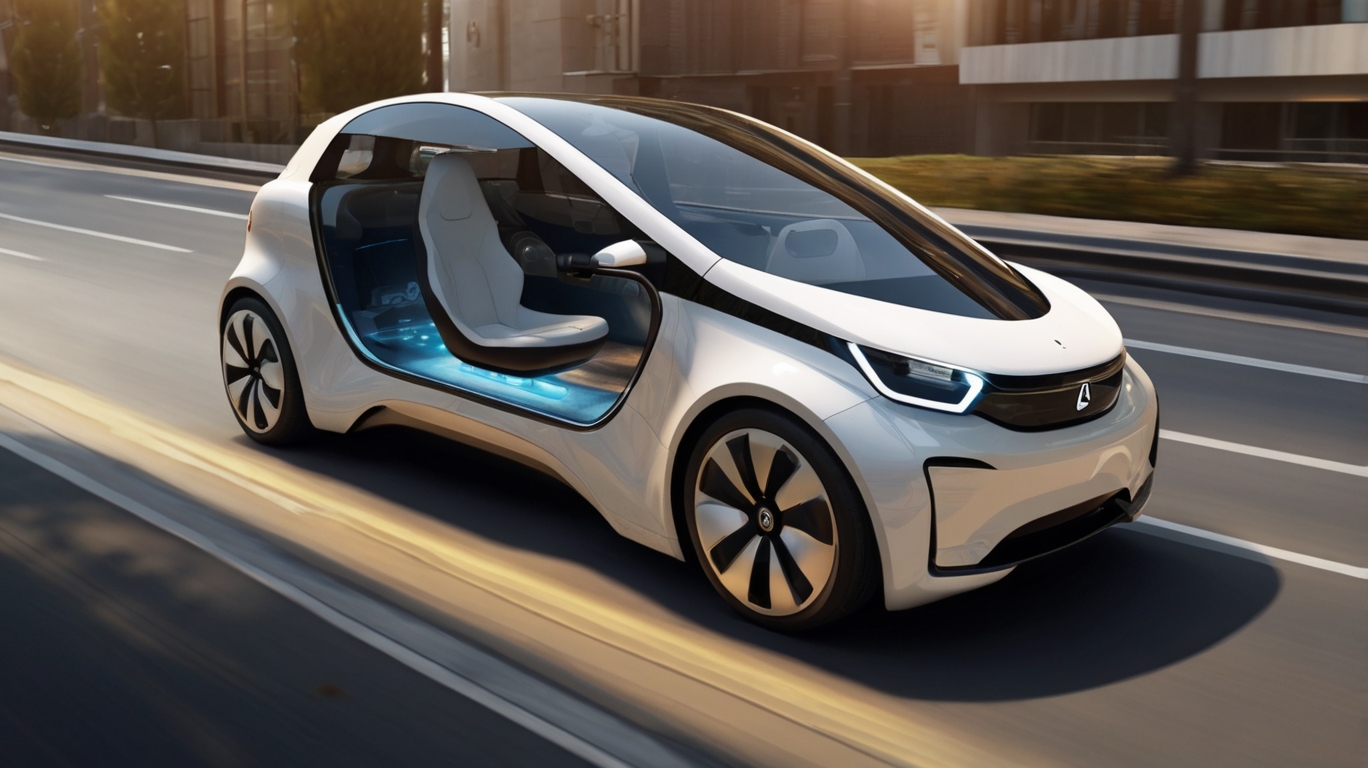Autonomous Cars and Smart Mobility:
Imagine a future where your daily commute is stress-free, traffic jams are a thing of the past, and your car knows exactly where you need to go without a single word. Sounds like science fiction, right? But this future is fast approaching thanks to the rise of autonomous vehicles and smart mobility systems. As we navigate deeper into the 21st century, the way we move from place to place is being transformed—driven by artificial intelligence, cutting-edge sensors, and a fundamental rethinking of urban infrastructure.
Autonomous cars are no longer experimental prototypes confined to research labs. They’re already on the roads in pilot programs across the globe, collecting data, learning, and evolving. Meanwhile, smart mobility—an ecosystem that integrates various forms of transport using technology—aims to create seamless, efficient, and eco-friendly ways to get around. Together, these innovations are reshaping not just transportation but the very fabric of our cities and societies.
So, what can we realistically expect in the next few years? Let’s take a closer look at the road ahead.
The Current Landscape of Autonomous Vehicles
Autonomous cars, also known as self-driving cars, are vehicles capable of sensing their environment and navigating without human input. They rely on a complex mix of technologies: LIDAR (Light Detection and Ranging), radar, GPS, high-definition cameras, and advanced machine learning algorithms. These systems work together to interpret surroundings, make decisions, and control the vehicle in real time.
Companies like Tesla, Waymo (a subsidiary of Alphabet), Cruise (owned by General Motors), and even legacy automakers like Ford and Mercedes-Benz are investing billions into autonomous vehicle development. While Tesla is known for its “Full Self-Driving” (FSD) software, which still requires human supervision, Waymo has launched fully driverless taxi services in select cities like Phoenix, Arizona.
Despite rapid technological advancements, widespread adoption of Level 5 autonomy—vehicles that require no human intervention in any scenario—is still years away. We are currently hovering between Level 2 and Level 4, with most consumer vehicles offering partial automation, such as adaptive cruise control and lane-keeping assistance.

Smart Mobility: The Bigger Picture
Smart mobility encompasses much more than just self-driving cars. It includes everything from electric scooters and bike-sharing systems to real-time traffic data platforms and integrated public transportation networks. The goal is to create an interconnected system where users can seamlessly plan and execute trips using a combination of transport modes.
Smart mobility is also about sustainability. Cities like Amsterdam, Copenhagen, and Singapore are already investing heavily in eco-friendly, tech-driven transportation. They are integrating mobility-as-a-service (MaaS) platforms that combine ride-sharing, public transit, and micromobility into a single digital interface, making urban travel more efficient and accessible.
As 5G and the Internet of Things (IoT) continue to expand, we can expect smart mobility systems to become more intelligent and responsive. Traffic signals will adjust in real time based on congestion levels. Vehicles will communicate with each other (V2V) and with infrastructure (V2I), leading to smoother traffic flow and fewer accidents.
The Benefits on the Horizon
The potential benefits of autonomous cars and smart mobility are enormous, especially when it comes to safety, efficiency, and the environment.
1. Reduced Traffic Accidents
One of the most promising benefits is the reduction of traffic-related fatalities. According to the World Health Organization, approximately 1.3 million people die each year in road crashes, with 90% attributed to human error. Autonomous vehicles, if deployed correctly, could drastically reduce this number. They don’t get distracted, drunk, or tired—and their reaction times are measured in milliseconds.
2. Increased Accessibility
Autonomous vehicles could revolutionize mobility for people with disabilities, the elderly, or anyone unable to drive. Imagine a world where someone who’s visually impaired can summon a vehicle via smartphone and safely reach their destination without assistance. This kind of accessibility has the potential to redefine social inclusion and independence.
3. Improved Traffic Flow
With smart algorithms managing routes and traffic lights in real time, we can expect significant reductions in congestion. This not only shortens commute times but also lowers fuel consumption and carbon emissions. Autonomous vehicles can drive more efficiently than humans, maintaining consistent speeds and reducing the need for stop-and-go traffic.
4. Environmental Impact
Many self-driving cars are being designed as electric vehicles (EVs), which further contributes to sustainability. Coupled with renewable energy sources and smart charging infrastructure, this shift could help cities dramatically reduce their carbon footprints. Fewer cars on the road due to shared mobility models will also play a key role in curbing pollution.
Challenges and Roadblocks Ahead
Of course, this vision isn’t without its challenges. For all the optimism, there are significant hurdles—technical, ethical, legal, and societal—that must be addressed before autonomous vehicles and smart mobility can reach their full potential.
1. Regulatory and Legal Issues
Different countries—and even different cities—have varying laws when it comes to autonomous vehicles. Standardizing regulations is a major hurdle. Who is liable in the event of an accident? The passenger? The manufacturer? The software provider? These legal gray areas must be resolved before mass deployment can occur.
2. Public Trust and Acceptance
Many people are still wary of giving up control to a machine. Trust in autonomous technology is fragile, especially when high-profile accidents occur. Companies must be transparent about safety testing and data collection, and governments must establish clear guidelines to build public confidence.
3. Cybersecurity and Data Privacy
With so much data being generated—from GPS locations to personal preferences—autonomous vehicles and smart mobility systems are attractive targets for hackers. Ensuring robust cybersecurity and protecting user privacy will be essential for maintaining trust and operational integrity.
4. Infrastructure Readiness
Our cities are not yet fully equipped to support smart mobility. Roads, signage, communication networks, and energy grids all require upgrades. Retrofitting existing infrastructure to accommodate autonomous vehicles and connected systems will require massive investment and coordination.
What to Expect in the Next 5-10 Years
While full autonomy might still be a decade or more away, we can expect significant progress in several key areas over the next 5 to 10 years.
1. Expansion of Driverless Ride-Hailing Services
Companies like Waymo, Cruise, and Uber will continue to expand autonomous ride-hailing services in select urban markets. Expect to see these services roll out in more cities with controlled environments and supportive regulations.
2. Autonomous Freight and Delivery
The logistics sector is likely to adopt autonomous technology faster than passenger transport. Autonomous trucks and delivery robots are already being tested for last-mile delivery. These applications operate in more predictable environments, making them ideal for early adoption.
3. Integration with Public Transit
Expect to see tighter integration between autonomous vehicles and public transport systems. Autonomous shuttles could serve as feeders to train and subway stations, especially in suburban or underserved areas. This hybrid model could significantly enhance urban mobility.
4. Vehicle-to-Everything (V2X) Communication
The rollout of 5G will accelerate V2X technology, allowing vehicles to communicate not just with each other but with infrastructure, pedestrians, and even cyclists. This will enhance situational awareness and improve overall traffic safety.
5. Increased Focus on Ethics and Policy
As autonomous systems become more prevalent, so too will discussions about ethics and public policy. Governments, ethicists, and industry leaders will need to collaborate on frameworks that prioritize safety, equity, and the public good.
The Human Element: A Cultural Shift
Technology alone won’t reshape mobility—people will. As autonomous vehicles become more common, society will need to adapt in terms of culture, behavior, and mindset.
We’ll need to rethink car ownership. Shared, on-demand mobility may become the norm, reducing the need for parking lots and personal vehicles. Urban planning will evolve to prioritize pedestrians and shared spaces, not just cars.
There will also be shifts in employment. Millions of people worldwide work as drivers—truckers, taxi drivers, delivery personnel. As automation increases, workforce retraining and social safety nets will become crucial components of a fair transition.
Perhaps most importantly, we’ll need to redefine our relationship with cars. For over a century, cars have symbolized freedom, status, and independence. In an autonomous future, the focus may shift from ownership to experience, from driving to riding, from isolation to connection.
Conclusion: Driving Toward the Future
The future of mobility is not a distant dream—it’s unfolding right before our eyes. Autonomous vehicles and smart mobility systems promise to make transportation safer, greener, and more inclusive. But this transformation will require more than just technological breakthroughs. It will demand cooperation across industries, bold policymaking, and an openness to cultural change.
As we steer toward this new era, one thing is certain: the road ahead is full of possibilities. Whether you’re a commuter, a policymaker, or a curious observer, now is the time to buckle up and embrace the journey.
The future isn’t just about getting from point A to point B—it’s about reimagining the entire journey.
Autonomous Cars and Smart Mobility:
FAQ: Autonomous Cars and Smart Mobility
1. What is an autonomous car?
An autonomous car, also known as a self-driving car, is a vehicle that can navigate and drive itself without human input. It uses a combination of sensors, cameras, radar, GPS, and artificial intelligence to understand its environment and make real-time driving decisions.
2. What are the levels of vehicle autonomy?
There are six levels of automation defined by the SAE (Society of Automotive Engineers):
- Level 0: No automation
- Level 1: Driver assistance (e.g., adaptive cruise control)
- Level 2: Partial automation (e.g., lane-keeping and acceleration, but driver must monitor)
- Level 3: Conditional automation (car can handle tasks, but human must be ready to take over)
- Level 4: High automation (no driver needed in specific conditions)
- Level 5: Full automation (no human input required at all)
3. Are autonomous cars already on the road today?
Yes. Several companies, including Waymo, Cruise, and Tesla, have deployed autonomous or semi-autonomous vehicles on public roads in pilot programs. However, most are still in testing or limited use, and full autonomy is not yet widely available.
4. What is smart mobility?
Smart mobility refers to the use of technology to create efficient, connected, and sustainable transportation systems. This includes ride-sharing apps, electric vehicles, integrated public transit systems, real-time traffic management, and more.
5. How do autonomous vehicles improve road safety?
Autonomous vehicles can reduce accidents caused by human error—such as distraction, fatigue, or impaired driving. They react faster than humans and maintain consistent driving behavior, potentially leading to fewer crashes and fatalities.
6. When will fully autonomous cars be available to the general public?
Experts predict that fully autonomous vehicles (Level 5) may become more widely available within the next 10–15 years. However, this timeline depends on regulatory approval, infrastructure development, public trust, and continued technological advancements.
7. What challenges do autonomous cars face?
Key challenges include:
- Legal and regulatory issues
- Cybersecurity and data privacy
- Public acceptance and trust
- Infrastructure readiness
- Ethical decision-making (e.g., how the vehicle handles accident scenarios)
8. How will autonomous vehicles affect jobs in the transportation industry?
Automation may impact millions of jobs, especially for drivers in trucking, taxi, and delivery services. Governments and businesses will need to invest in retraining and transition support for affected workers.
9. Will people still own cars in the future?
Possibly less so. Many experts believe the future will see a shift toward shared, on-demand mobility services (like autonomous taxis and ride-shares), reducing the need for private car ownership—especially in cities.
10. How do autonomous vehicles help the environment?
Most autonomous vehicle initiatives are tied to electric vehicle (EV) platforms, which reduce greenhouse gas emissions. Additionally, improved traffic flow and fewer cars on the road can lower fuel consumption and air pollution.
11. What is Vehicle-to-Everything (V2X) communication?
V2X is a communication system that allows vehicles to interact with other vehicles (V2V), infrastructure (V2I), pedestrians (V2P), and networks. It enhances safety, traffic efficiency, and situational awareness.
12. How can cities prepare for smart mobility?
Cities can:
- Invest in connected infrastructure
- Support the rollout of 5G networks
- Create regulatory frameworks
- Encourage electric and shared mobility
- Rethink urban planning to prioritize people over cars
Read also :




